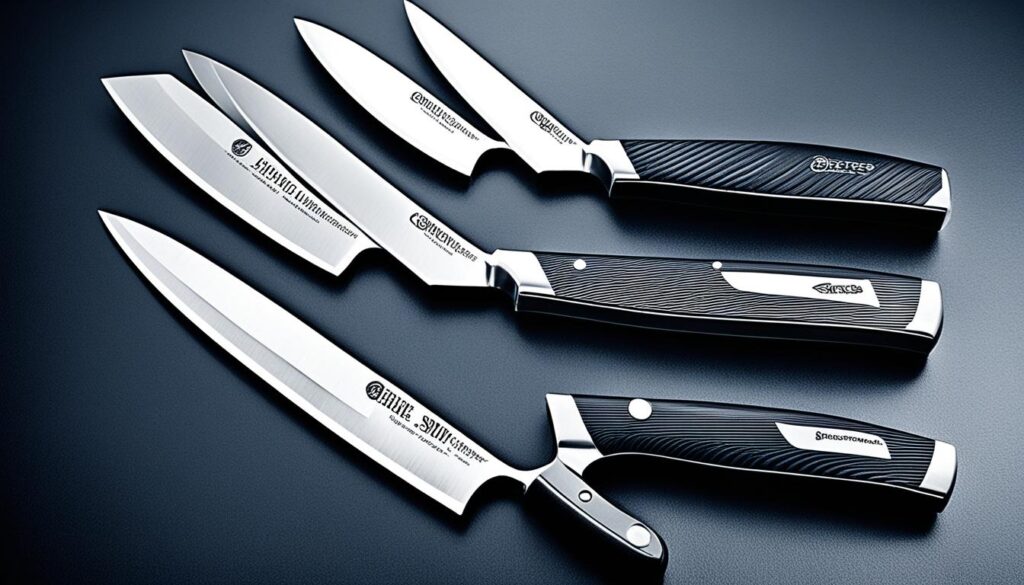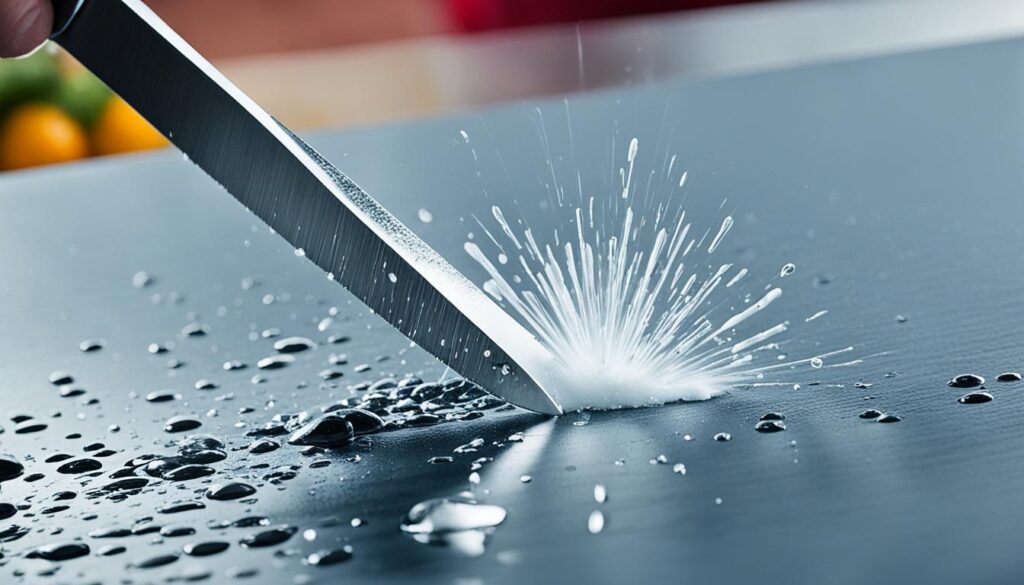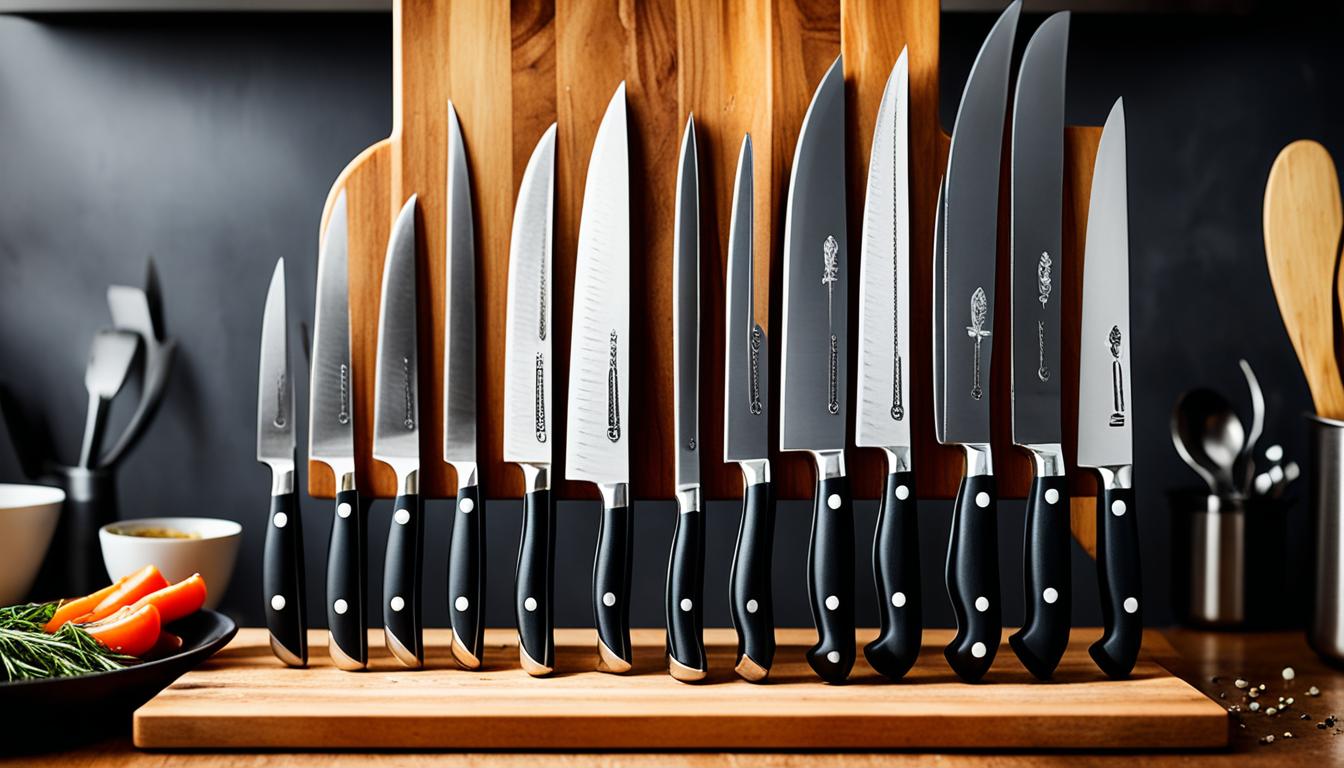When it comes to preparing delicious meals, having the right tools is essential. And there’s one tool that every professional chef and serious home cook knows they can’t live without – a high-quality chef’s knife. But with so many options on the market, how do you choose the best one?
In this comprehensive guide, we will take a closer look at some of the top chef’s knives available, exploring their features, performance, and overall value. Whether you’re a seasoned chef or an aspiring home cook, we’ve got you covered. Get ready to discover the perfect cutting companion that will elevate your culinary creations!
Key Takeaways:
- Choosing the right chef’s knife involves considering factors such as blade material, weight, sharpness, and handle design.
- The Wusthof Classic 8-inch Chef’s Knife is a top-rated option for its durability and cutting power.
- Other chef’s knives worth considering include Sekimagoroku Akane, Our Place Everyday, Tojiro Professional, Steelport, Shun Classic Blonde, Shun Kazahana, Made In, and Mercer Culinary Renaissance.
- Proper maintenance and sharpening are essential for keeping your chef’s knife in optimal condition.
- Choosing between traditional Western-style knives and Japanese-style knives depends on personal preference and the desired cutting motions.
Wusthof Classic 8-inch Chef’s Knife
The Wusthof Classic 8-inch Chef’s Knife is a top-rated option for professional chefs and home cooks alike. With its blend of high-quality materials and superior craftsmanship, this knife is designed to elevate your culinary experience.
Featuring a higher steel-to-carbon ratio, the Wusthof Classic offers exceptional durability and long-lasting sharpness. This means that you can rely on this knife to effortlessly slice through even the toughest ingredients, ensuring precision and efficiency in your kitchen.
One of the standout features of the Wusthof Classic is its deep, rounded belly and heft. This design provides excellent control and cutting power, making it the perfect tool for a wide range of kitchen tasks, from chopping and dicing to mincing and slicing.
While the weight of the Wusthof Classic may take some getting used to for those accustomed to lighter knives, it is precisely this heft that gives it its unique cutting capabilities. The knife’s weight, combined with its ergonomic handle, ensures optimal balance and stability, allowing you to work with precision and confidence.
Whether you’re a professional chef or a passionate home cook, the Wusthof Classic 8-inch Chef’s Knife is a reliable choice that will exceed your expectations. Its exceptional performance, durability, and cutting-edge design make it one of the best chef’s knives on the market. Experience the difference that a high-quality culinary knife can make in your kitchen.
Factors to Consider When Choosing a Chef’s Knife
When it comes to selecting the best chef’s knife, there are several important factors to consider. These factors play a crucial role in determining the knife’s performance, durability, and overall suitability for your culinary needs. Let’s take a closer look at the key considerations:
- Weight: The weight of a chef’s knife can significantly impact its usability and maneuverability. A heavier knife with a curved blade is ideal for a rocking motion, making it suitable for tasks like mincing and chopping. On the other hand, a lighter, thin blade is better for delicate slicing motions.
- Blade Thickness and Shape: The thickness and shape of the blade can affect the knife’s cutting performance. Thicker blades are generally more durable and can handle tougher ingredients, while thinner blades provide precision and are better suited for tasks that require cleaner cuts.
- Handle Design: The handle plays a crucial role in providing comfort and control while using the knife. It should be ergonomic, allowing for a secure and comfortable grip. The handle material should also be durable and resistant to moisture and heat, ensuring longevity.
- Sharpness: The sharpness of a chef’s knife is a vital aspect to consider. A razor-sharp blade ensures efficient cutting and reduces the risk of accidents. Look for knives with high-quality steel blades that offer long-lasting sharpness for prolonged use.
- Overall Quality: The overall quality of a chef’s knife encompasses various aspects, including the construction, materials used, and attention to detail. Choose knives from reputable brands known for their commitment to craftsmanship and durability.
Considering these factors will help you make an informed decision and find a chef’s knife that meets your specific requirements.

| Factors to Consider | Consideration Details |
|---|---|
| Weight | A heavier knife for rocking motion or a lighter knife for slicing motions |
| Blade Thickness and Shape | Thicker blades for durability and tougher ingredients, thinner blades for precision and cleaner cuts |
| Handle Design | Ergonomic and comfortable grip, durable and moisture-resistant material |
| Sharpness | Razor-sharp blades for efficient cutting and reduced accidents |
| Overall Quality | Construction, materials, and attention to detail from reputable brands |
Other Chef’s Knives Reviewed
In addition to the Wusthof Classic, there are other top-rated chef’s knives on the market that are worth considering. These knives have been carefully selected based on their quality, performance, and overall value. Let’s take a closer look at each one:
Sekimagoroku Akane 8-inch Chef’s Knife
The Sekimagoroku Akane 8-inch chef’s knife is renowned for its exceptional sharpness and precision. It effortlessly cuts through most ingredients with ease. However, some users have found that it may struggle when dealing with tougher vegetables. Nevertheless, its high-quality construction and affordable price make it a popular choice among professional chefs and home cooks.
Our Place Everyday Chef’s Knife
The Our Place Everyday chef’s knife stands out with its unique grip design and full-tang construction. The grip provides excellent control, while the full tang adds balance and durability. This knife is great for everyday use and performs exceptionally well across various cutting tasks.
Tojiro Professional Chef’s Knife
The Tojiro Professional chef’s knife combines the best of Western and Japanese design elements, making it a versatile option for any kitchen. With its sharp edge and ergonomic handle, this knife excels in precision slicing, chopping, and dicing.
Steelport 8-inch Chef’s Knife
The Steelport 8-inch chef’s knife is not only a functional tool but also a beautiful showpiece in the kitchen. Its stunning burl wood handle and razor-sharp carbon steel edge make it a pleasure to use. This knife is perfect for chefs who appreciate both aesthetics and performance.
Shun Classic Blonde Chef’s Knife
The Shun Classic Blonde chef’s knife is a lightweight and comfortable option for those who prefer a sleek design. It glides effortlessly through ingredients, allowing for smooth and precise slicing motions. This knife is a favorite among many professional chefs.
Shun Kazahana Chef’s Knife
The Shun Kazahana chef’s knife offers exceptional sharpness and durability. Its beautifully crafted blade delivers impressive cutting performance. However, some users may find the handle to be less comfortable than other options.
Made In Chef’s Knife
The Made In chef’s knife boasts incredible sharpness, allowing for effortless cutting. However, it is important to note that the blade may dull more quickly with use. This knife is favored by chefs who prioritize efficiency in their kitchen.
Each of these chef’s knives has its own unique strengths and characteristics. Consider your specific needs and preferences to choose the one that will best suit your culinary endeavors.
How to Maintain and Sharpen a Chef’s Knife
Proper maintenance and sharpening are essential for keeping a chef’s knife in optimal condition. Regular honing with a honing rod helps align the blade and maintain its sharpness. Using a knife sharpener, like a whetstone, can help remove steel from the blade to create a sharper cutting edge. It’s important to properly dry the knife before storage to prevent corrosion. While professional sharpening is an option, it should be done sparingly to prevent excessive removal of steel.
Here are some key steps to maintain and sharpen your chef’s knife:
- Hone the knife regularly using a honing rod to realign the blade’s edge.
- Use a knife sharpener, such as a whetstone, to remove steel and create a sharper cutting edge. Follow the manufacturer’s instructions for optimal results.
- Properly dry the knife after cleaning and before storage to prevent corrosion. Avoid leaving the knife wet or in a humid environment.
- Store the knife in a knife block, knife sheath, or on a magnetic strip to protect the blade and ensure safety.
- Consider professional sharpening services for maintaining the knife’s edge. However, be cautious not to sharpen the knife too frequently, as excessive removal of steel can shorten its lifespan.
Regular maintenance and sharpening will help prolong the life of your chef’s knife and ensure its optimal performance in the kitchen.

Quick Tips for Chef’s Knife Maintenance:
- Wash the knife by hand with mild soap and warm water, avoiding harsh detergents or abrasive scrubbers.
- Avoid cutting on hard surfaces like glass, stone, or metal, as it can dull the blade.
- Use a cutting board made of wood, bamboo, or plastic to protect the knife and maintain its sharpness.
- Avoid twisting or prying with the knife, as it can damage the blade or handle.
- Regularly inspect the knife for any signs of wear, such as loose handles or chips in the blade. If necessary, consult a professional for repairs.
Proper maintenance and sharpening are crucial for keeping your chef’s knife in top shape. With regular care, your knife will continue to perform at its best, making your chopping, slicing, and dicing tasks a breeze. Remember to prioritize safety and follow these maintenance tips for a long-lasting cutting tool.
| Knife Maintenance Steps | Frequency |
|---|---|
| Honing the knife with a honing rod | Every 2-3 uses |
| Using a knife sharpener (whetstone) | As needed, when the blade starts to dull |
| Drying the knife before storage | After each use |
| Storing the knife properly | Ongoing |
| Professional sharpening | As needed, approximately once or twice a year |
Traditional vs. Japanese Chef’s Knives
When choosing a chef’s knife, one important decision to make is whether to go for a traditional Western-style knife or a Japanese-style knife. Both options have their unique features and advantages, catering to different preferences and cooking techniques.
Traditional Western-Style Knives
Traditional Western-style knives, often associated with German craftsmanship, are renowned for their durability and versatility. These knives typically have thicker, heavier blades with a curved shape, making them ideal for rocking motions and chopping tasks. The weight of the blade provides stability and power, allowing for efficient slicing through tough ingredients. Western-style knives are often favored by chefs who rely on precision and control in their culinary endeavors.
Japanese-Style Knives
Japanese-style knives are known for their elegance, exceptional sharpness, and precision. These knives are typically lighter, thinner, and straighter, making them perfect for precise slicing motions, such as making paper-thin cuts or intricate vegetable decorations. Japanese knives often feature single bevel edges, enhancing their cutting efficiency. However, their thinner blades require additional care to prevent damage or chipping, and the harder steel used may require specialized sharpening techniques and expertise.
Both traditional Western-style knives and Japanese-style knives have their own merits, catering to different cooking styles, preferences, and skill levels. The choice between the two ultimately depends on personal preference and the specific culinary needs of the individual.
When selecting a chef’s knife, it’s essential to consider factors such as weight, blade thickness and shape, handle design, sharpness, and overall quality. Researching reputable brands and reading reviews can assist in making an informed decision. Ultimately, finding a chef’s knife that feels comfortable and responsive in your hand is key to enjoying an enhanced cooking experience.
Conclusion
When it comes to finding the best chef’s knife, it ultimately depends on your personal preference and culinary needs. We have reviewed some of the top-rated knives on the market, including the Wusthof Classic 8-inch Chef’s Knife, known for its durability and cutting power. However, there are several other options worth considering, such as the Sekimagoroku Akane, Our Place Everyday, Tojiro Professional, Steelport, Shun Classic Blonde, Shun Kazahana, Made In, and Mercer Culinary Renaissance chef’s knives.
Proper maintenance and sharpening are essential for keeping your chef’s knife in top condition. Regular honing with a honing rod and using a knife sharpener, like a whetstone, can help maintain its sharpness and effectiveness. Remember to properly dry the knife before storage to prevent corrosion.
Whether you prefer a traditional Western-style knife or a Japanese-style knife, the key is to find a knife that feels comfortable and responsive in your hand. Consider factors such as weight, sharpness, handle design, and overall quality when making your decision. With the right chef’s knife by your side, you can elevate your culinary skills and enjoy a seamless cutting experience. Happy cooking!
